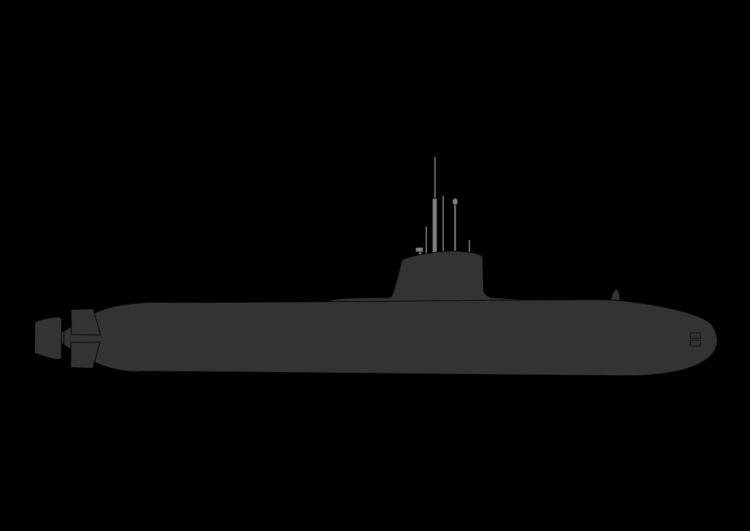Name Barracuda class Operators French Navy Built Since 2007 | Builders DCNS Preceded by Rubis class | |
 | ||
Cost €9.9bn (FY2013) for six boats
€1,300m (FY2013) per unit | ||
The Barracuda class (or Suffren class) is a new nuclear attack submarine, designed by the French shipbuilder DCNS for the French Navy, replacing the Rubis-class submarines. Construction began in 2007 and the first unit will be commissioned in 2018.
Contents
Barracudas will use technology from the Triomphant class, including pump jet propulsion. This class reportedly produces approximately 1/1000 of the detectable noise of the Redoutable-class boats (submarines), and they are ten times more sensitive in detecting other submarines. They will be fitted with torpedo-tube-launched cruise missiles MDCN SCALP Naval for long-range (well above 1,000 km, 620 mi) strikes against strategic land targets. Their missions will include anti-surface and anti-submarine warfare, land attack, intelligence gathering, crisis management and special operations. The Barracuda type will use X-shaped stern planes.
History
In October 1998, the Delegation Générale pour l'Armement, the French government's defense procurement agency, established an integrated project team consisting of the Naval Staff, DCN, Technicatome and the Commissariat a l'Énergie Atomique, a regulatory body that oversees nuclear power plants, to oversee the design of a new attack submarine class. DCN was to be the boat's designer and builder while Technicatome, since absorbed Areva company, was to be responsible for the nuclear power plant. The two companies were to act jointly as a single prime contractor to share the industrial risks, manage the schedules, and be responsible for the design's performance and costs, which at the time was estimated to be US$4.9 billion.
According to the contract signed in December 2006, the first boat was to commence sea trials in early 2016, with delivery occurring in late 2016/early 2017. This was to be followed by entry into service in late 2017.
As of early 2016, the first new Barracuda-class submarine, Suffren will start sea trials in spring 2017, with delivery anticipated in late 2017 and commissioning into service in 2018.
DCNS also designed a conventionally powered derivative, dubbed the SMX-Ocean, featuring fuel-cells and vertical launchers.
Another conventionally powered design, the Shortfin Barracuda, was selected as a future replacement for the Collins-class vessels with the Royal Australian Navy.
In 2016, DCNS also began to position itself and its Suffren/SMX Ocean design in the Royal Canadian Navy's Future Canadian Submarines project. The project is planned to replace the Victoria-class submarines by 2030.
Description
The Barracuda class nuclear reactor incorporates several improvements over that of the preceding Rubis. Notably, it extends the time between refuelling and complex overhauls (RCOHs) from 7 to 10 years, enabling higher at-sea availability.
In support of special operations missions, Barracudas may also accommodate up to 12 commandos, while carrying their equipment in a mobile pod attached aft of the sail.
On 22 December 2006, the French government placed a €7.9 billion order for six Barracuda submarines with DCNS and their nuclear powerplants with Areva-Technicatome. According to the DGA “Competition at the subcontractor level will be open to foreign companies for the first time.” The first submarine will be delivered in 2016. Alain Aupetit, DCNS's Barracuda programme director, said "The gap between the delivery of boats one and two will be two-and-a-half years.... After that, we will deliver one boat every two years through to the delivery of the last submarine in 2026."
Shortfin Barracuda conventional variant
DCNS submitted a conventionally powered diesel-electric variation to the design – named the Shortfin Barracuda Block 1A – to the competitive evaluation process (CEP) phase of Australia's Collins-class submarine replacement. "While exact details remain confidential, DCNS can confirm the Shortfin Barracuda is over 90 metres in length and displaces more than 4,000 tons when dived," said Sean Costello, CEO DCNS Australia. DCNS was chosen by the Australian Government on 26 April 2016 to build 12 of the Shortfin Barracuda Block 1A variant at a projected AUD$50 billion. Much of the works will be undertaken at ASC Pty Ltd in Adelaide, South Australia.
